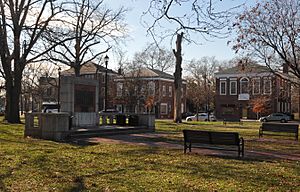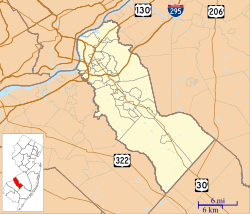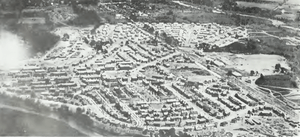Fairview, Camden facts for kids
Quick facts for kids
Fairview Village
|
|
|---|---|

A memorial in Yorkship Square, surrounded by residential buildings.
|
|
| Nickname(s):
Yorkship Village
|
|
| Country | |
| State | |
| County | Camden |
| City | Camden |
| Elevation | 6 m (20 ft) |
| Time zone | UTC−05:00 (Eastern (EST)) |
| • Summer (DST) | UTC−04:00 (EDT) |
| ZIP Code |
08104
|
| Area code(s) | 856 |
| GNIS feature ID | 0881986 |
|
Fairview Historic District
|
|
 |
|
| Location | Hull Rd and Olympia Rd.; Mount Ephraim Ave.; Crescent Boulevard; North-South Freeway Camden, New Jersey |
|---|---|
| Area | 225 acres (0.91 km2) |
| Built | 1918 |
| Architect | Electus Darwin Litchfield |
| NRHP reference No. | 74001157 |
| Significant dates | |
| Added to NRHP | November 1, 1974 |
Fairview is a neighborhood in southern Camden, New Jersey. It was originally called Yorkship Village. This area is special because much of it is a historic district. This means it's recognized on both state and national lists for its important history. In 2000, about 5,947 people lived in Fairview Village.
Contents
A Look Back: The Story of Fairview
Fairview has a unique past. It was built during World War I (WWI) as a special "planned community." This means it was designed from scratch, not just built piece by piece. The main goal was to provide homes for workers at the New York Shipbuilding company in Camden.
Building a Home for Shipyard Workers
During WWI, the New York Shipbuilding company grew very fast. Many new workers came to Camden, but there weren't enough homes for everyone. To solve this, the United States government stepped in. The United States Shipping Board created the Emergency Fleet Corporation. This group used money to build housing for shipyard workers.
They chose Electus Darwin Litchfield as the architect. He was the person who designed the entire village. The chosen spot was a 225-acre piece of land. It was near the shipyard, on the South Branch of Newton Creek.
A Special Design: The Garden City Idea
Litchfield had a big vision for Yorkship Village. He wanted it to be a beautiful place with lots of light and clean spaces. He planned for playgrounds and fields where people could have fun. His goal was to create a community where families could live well. They could find strength and enjoyment after a long day of work.
The design of Yorkship Village was inspired by the "garden city movement." This was a new idea from England. It focused on creating towns with green spaces and a good quality of life. Litchfield's plan included narrow, winding streets. These streets would soon be lined with trees. There was also a central village square and wide, green boulevards. The homes were brick duplexes and row homes. They all had both front and back yards. The buildings were designed in the American Federal style. The village was also surrounded by Newton Creek on three sides. This made it feel like its own separate community.
From Village to City: Joining Camden
Construction of Yorkship Village began on May 1, 1918. The Emergency Fleet Corporation paid for the entire project. It cost about $11 million. However, they needed the local community to provide services. These included utilities, fire hydrants, and police protection. At the time, Yorkship Village was part of Haddon Township. But Haddon Township couldn't afford these services. So, on July 8, 1918, Yorkship Village became part of the City of Camden.
After WWI ended, the Emergency Fleet Corporation started selling the properties. There were many homes, apartments, and even stores. By 1924, almost all the buildings were sold. Only a few houses and public areas like parks remained unsold.
A Name Change and Lasting Legacy
Yorkship Village became the 14th Ward of Camden. In 1922, its name was changed to Fairview. However, the original elementary school near the square is still called Yorkship School. Also, all the streets in the area are still named after famous naval vessels. This keeps a piece of the village's original history alive.





